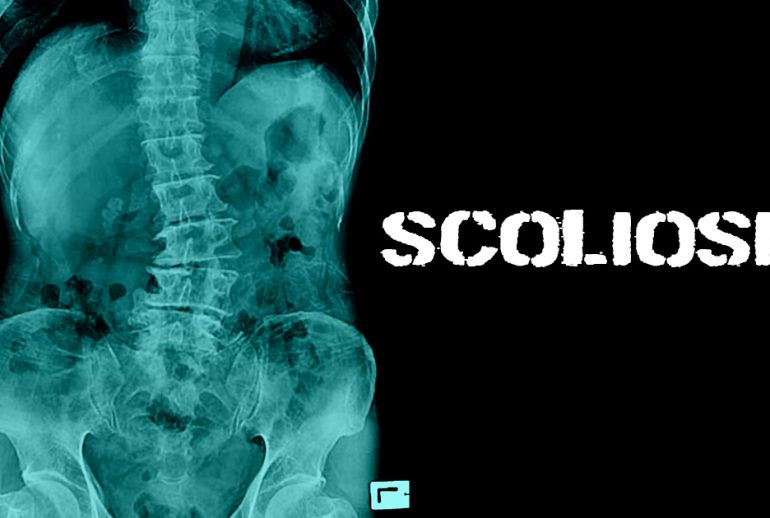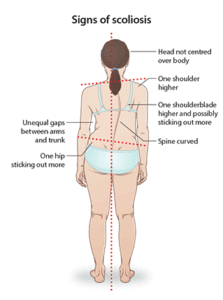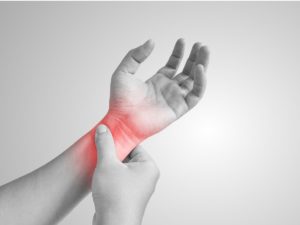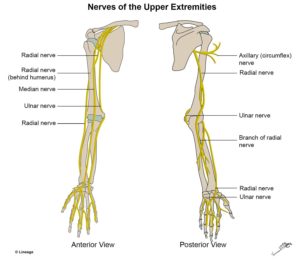What is Scoliosis?
Scoliosis is a general term for an abnormal or exaggerated curvature in the spine. When a scoliotic curve develops it involves a sideways bend of the spine with rotation through the y axis. As well as cosmetic changes, there are many physiological changes and long term consequences associated with it.
Types of Scoliosis:
Congenital – a type you are born with due to the spine not developing fully in the womb. Sometimes the vertebra in the spine don’t develop correctly and cause the spine to grow unevenly. Commonly associated with other congenital abnormalities in other body systems, such as the heart and kidney.
Idiopathic – a curve in the spine that develops as the child grows with an unknown cause. Categorised as:
- Infantile Idiopathic when changes occur before 2 years of age
- Juvenile Idiopathic with changes between 2 and 10 years old
- Adolescent Idiopathic Scoliosis (AIS) involve changes occurring between 10 and 18 years of age.
Neuromuscular – diseases that affect the central nervous system may result in the development of scoliosis. Neurological conditions that cause damage to the brain or nerves affect the muscle-nerve pathways of the body. Examples include spina bifida or cerebral palsy. Muscular conditions such as Duchenne Muscular Dystrophy or Multiple Sclerosis stop the muscles from working, therefore increasing the chance of developing a scoliotic curve with muscle weakness causing the spine to collapse into a C shape.
Scoliosis stats:
- More than 80% of cases are idiopathic, meaning there’s no known cause.
- AIS requiring treatment is much more common in girls than boys, with a ratio of 1:8 boys to girls.
- Any sideways spinal curvature of at least 10 degrees, measured on an X-ray of the spine, is considered scoliosis. However, a small curve of that size may not show any signs or symptoms.
- The person, or a parent, may begin to notice changes such as clothes hanging unevenly or the body tilting to one side as the curve progresses to 20 degrees or beyond.
Who gets Scoliosis?
The primary age of onset is 10-15 years of age affecting both males and females, however, as mentioned earlier, girls are 8 times more likely to progress to a curve size that requires treatment.
What to look for?
There are a few simple signs you can look out for, in particular as a parent to screen your kids at home. Looking at your child’s posture from behind, observe to see if the head is off centre over the body. Then as you go down, looking at the levels of the shoulders to see if one is higher than the other and similarly looking to see if one scapula (shoulder blade) sits higher than the other or possibly sticks out more. Continuing to look at posture, looking at the spine to see a potential curve that produces an unequal gap between the arms and trunk when compared to the other side and any signs of one hip sticking out more and sitting higher.
How can our treatment help?
As health practitioners here at Health House Clinics, we can’t treat scoliosis as a condition, but we can definitely assist with management. Through spinal manipulation and adjustments we can restore joint dysfunction in surrounding spinal joints, particularly focusing on pelvic alignment. As well as assessing for leg length differences and pronation of the feet that may be consequences of the spinal curve. Soft tissue massage and trigger point dry needling are great for helping muscle imbalances and muscle activation to help with postural stress and pain.
Interventions for Advanced Scoliosis:
Minor curves under 25 degrees don’t require any treatment or specific intervention, just observation through the growth phase and physical therapy and spinal manipulation to help maintain function. Further interventions may need to be taken with curves over 25 degrees to reduce the risk of progression. These may include:
Bracing – Bracing aims to control a curve and contain the progression of the curve angle through external forces. Bracing is a good starting point and can be successful in the attempt to avoid surgery.
Surgery – there has been major advances in surgical techniques for the correction of spinal deformity from all causes in the past few years. The basic principle is to apply some form of internal fixation to the spine and to correct the curve within the limits of safety. This usually involves the application of stainless steel rods, hooks and screws to the spine in the corrected position. Then join the vertebrae together by a spinal fusion with a bone graft from the patient’s pelvis. Many factors The indications for a particular technique are influenced by many factors.
References:
https://www.medicalnewstoday.com/articles/190940.php
https://www.healthdirect.gov.au/scoliosis
https://www.spine-health.com/conditions
http://www.aans.org/Patients/Neurosurgical-Conditions-and-Treatments
http://www.medtronic.com/au-en/your-health/conditions




